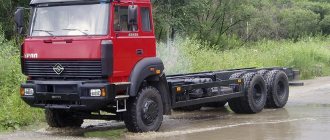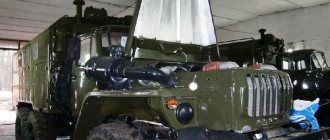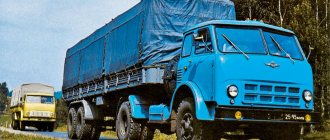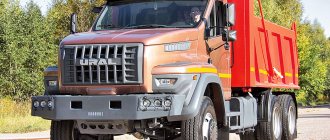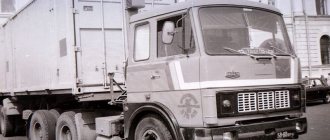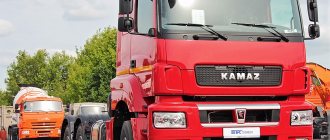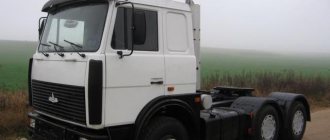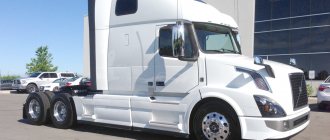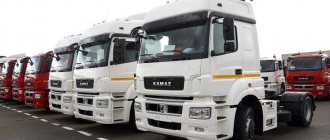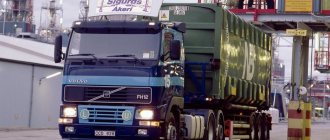Has no direct competitors
Daniil Minaev, photo by the author
The exposition of the GAZ Group at the COMTRANS'2017 exhibition pleased not only with its voluminous abundance, but also surprised with a number of premieres. AZ "URAL" from Miass brought two new "Urals" of the NEXT generation with a 6x4 wheel arrangement, are "Urals" returning to paved roads? As soon as the shutter of my camera clicked, I was taken under the care of representatives of the car plant. Here's what we found out.
Two vehicles of the Ural NEXT brand, which have drive wheels only on the rear axles, flaunted in the form of a general-purpose dump truck (model C25.330) and a truck tractor with a sleeper (model T25.422). It is not difficult to guess that in these indices the letter means the purpose of the equipment, then two digits of the gross vehicle weight index and engine power in horsepower. According to representatives of the automobile plant, these trucks were built to demonstrate the capabilities of the enterprise and identify the potential of such equipment on the market. The technically permissible weight and loads of the Ural NEXT 6x4 family are slightly higher than will be stated after the certification of the vehicles, this will allow them to be used not only on public roads, but also on technological “highways”.
01-Ural-NEXT_zr-09_15
Ural Next. From 2,794,000 rubles.
Where to take your first test drive of a rugged four-wheel drive truck? Of course, where there are really no roads - in the Ural Mountains! The places near Yekaterinburg are beautiful, almost like Switzerland. Although it looks like Karelia: dirt and rocky forest roads, steep climbs strewn with boulders. In the lowlands there are streams and rivulets, and even swamps. For trucks of all generations, the Ural is their native habitat. I was rushing along a forest road in sixth gear (out of nine possible), out of habit I slightly exceeded the speed and did not see the bump across the track. The Ural literally jumped out on it. If the seat didn't have air suspension, I wouldn't envy myself.
Then the blue sky behind the glass quickly gave way to the prospect of such a rut filled with rainwater. Bang! Thick spray covered the hood, windshield and even the doors. The water mixed with silt and sand completely deprived the view. Almost blindly, at a speed of sixty, I fly a half-destroyed log deck across a stream. The road rises again, and I manage to turn on the windshield wipers...
We crawled over slippery boulders and stormed steep slopes, overcame fords and tried to “break” the rear suspension balancers in gullies. And yet this cannot be called a serious test - just a fleeting acquaintance. But 25–30 kilometers along heavy forest roads showed that the ennobled Ural Next has not lost its main properties - all-terrain capability.
Modifications
When you need to purchase a Ural Next with a sleeping bag or another version of it, it is advisable to familiarize yourself with the existing modifications of this model. They are widely available on sale, due to the scope of application of these universal cars. Among the main variations that are most popular are the following models:
- tent;
- onboard;
- dump trucks;
- shift workers;
- cargo-passenger;
- tractor units;
- fuel tankers;
- timber trucks;
- fuel trucks;
- truck cranes.
Be sure to read: BELAZ 130 tons: characteristics, cost
There are many other modifications, but these types of Ural Next trucks seem to be the most popular. In addition to the type of equipment installed on the vehicle base, trucks of this model differ from each other in terms of wheel arrangement and chassis length. 4x4 and 6x6 versions are available to consumers, which allows them to choose the optimal solution for any operating conditions.
Driver's cabin
02-Ural-NEXT_zr-09_15
A well-thought-out workplace in a unified next-cab will certainly appeal to drivers.
A well-thought-out workplace in a unified next-cab will certainly appeal to drivers.
A well-thought-out workplace in a unified next-cab will certainly appeal to drivers.
STAGES OF THE DIFFICULT PATH
The current update of Miass trucks is taking place in two stages. At the first, the Urals received a new engine, transmission, units and some components - in particular, a pneumatic braking system instead of a pneumohydraulic one and a different steering mechanism. Such vehicles are called Ural M, and they can be either with the classic Ural-375/4320 cab or with the licensed cabover Iveco TurboStar (cabin P, “pi”). If a cab from Gazelle Next is installed on the Ural M chassis, then this is already Ural Next - and, therefore, the second stage of modernization has been completed.
The engine is YaMZ-536 with a volume of 6.65 liters, the most modern domestic turbodiesel. The new Yaroslavl YaMZ-530 family consists of four- and six-cylinder engines developed jointly with the Austrian engineering company AVL List GmbH. The last digit in the engine index indicates the number of cylinders. Now a new plant in Yaroslavl produces about two dozen modifications of the YaMZ-536 engine, including a gas version. The expansion of production volumes is facilitated by the widespread unification of the YaMZ-536 with the four-cylinder diesel engine YaMZ-534, which is installed on Lawn Next, GAZ-3309, and PAZ buses.
The design of the engine is typical for modern diesel engines in the “liter per cylinder” segment: the cylinder block and the common head with four valves per cylinder are cast from cast iron, the liners are replaceable wet, the timing drive is located on the flywheel side. Turbocharging, intercooler, Common Rail power system with a rail pressure of 1800 bar for the Euro 4 version. Compliance with Euro-3 and Euro-4 standards is achieved using the most modern version of the EGR system - with liquid cooling of the exhaust gases mixed with a fresh air charge. The EGR system can be supplemented with a particulate filter, but this is in the future (Euro 5 level). So far, Yaroslavl engineers have decided not to use AdBlue urea solution on their new in-line engines, and for the Urals in Russia, as for all-terrain vehicles, recirculation is not needed.
History of the model
If you want to know how the Ural Next mainline tractor differs from other domestic analogues, it is advisable to familiarize yourself with the history of this model. It began in 2015, when the GAZ automobile concern presented a new generation of trucks at the Moscow construction equipment exhibition. The public was immediately shown 4 main modifications, adapted for specific tasks.
The Ural-M chassis was used as the basis for the new product, which underwent major changes during the development process. The new model was equipped with a more modern pneumatic braking system, and they decided to use the latest generation YaMZ engines as the power unit.
The car was created in 2015
Engineers paid special attention to the service life of the transmission and chassis, which significantly increased their strength and reliability. The car was also equipped with an integral steering mechanism and an updated cabin, which is capable of providing the driver with a significantly greater level of comfort than before.
When planning to study the Ural Next 4x4 and other modifications in more detail, you must remember that they are intended for use in conditions of low-quality road surfaces. This makes them a universal and reliable solution even for those regions where roads are almost completely absent.
04-Ural-NEXT_zr-09_15
The three tested cars had turbodiesels with the same power setting of 312 “horses” at 2300 rpm and with a torque of 1240 Nm - so far this is the limit for the YaMZ-536. There are weaker versions: 240, 270 and 285 hp, torque from 900 Nm at 1300–1600 rpm. And the shift bus was equipped with a 240-horsepower engine, converted to a gas-diesel cycle (methane plus diesel fuel).
The diesel engine is quiet and without unnecessary vibrations. There is no point in comparing it with the old YaMZ V-shaped “six” - these are different engines. Specific fuel consumption at rated power is 140 g/kWh. And if the YaMZ-236 diesel engine weighs 995–1050 kg, the KamAZ-740 - 743 kg, then the YaMZ-536 weighs only 640 kg.
The flywheel housing has a unified fastening according to the SAE1 standard, which makes it possible to install gearboxes from foreign and domestic manufacturers. I managed to drive a car with a modernized Yaroslavl five-speed gearbox: it is still quite suitable for such add-ons as a truck crane, shift truck or fire truck - that is, for working without a trailer. But the flagship for Ural Next is the nine-speed ZF-Ecomid 9 S 1310 TO, which is produced by the TsF-Kama joint venture in Naberezhnye Chelny. These same ZF boxes are used not only on new models of Kama trucks, but also on heavy versions of medium-duty vehicles, such as DAF LF, Renault Midlum, MAN TGL, Iveco Eurocargo.
Specifications
Many car enthusiasts prefer to buy a Ural Next with a double cab, as well as other modifications of this truck, due to its excellent performance. Among them, it is worth mentioning the following parameters:
- dimensions (LxWxH) - 7.633x2.259x2.952 m, depends on the specific modification;
- ground clearance - 40 cm;
- load capacity - 5.5-12.5 tons;
- curb weight - 6.645-8.245 tons;
- Fuel consumption per 100 km - from 38 liters.
The manufacturer guarantees the correct operation of all structural elements for 2 years or 100,000 km, and the maintenance interval is 15 thousand km. Since many elements of the car have been significantly redesigned in comparison with previous models, you need to familiarize yourself with it in more detail.
When figuring out how much such a vehicle costs, it should be noted that the initial cost of new trucks in the most budget-friendly flatbed version starts from 2.9 million rubles.
There are no used models with a strong difference in price on the market, but 2016 models are sold for 2.6 million rubles and more.
Engine
The main power unit of this model is the YaMZ-536, which belongs to the category of 4-stroke diesel engines. It is equipped with 6 cylinders, as well as a liquid cooling system, which allows it not to overheat during intensive work. The motor is considered an innovative development of the Yaroslavl plant, since it was produced with the assistance of the Austrian concern AVL List GmbH.
The power of the forced engine reaches 312 hp, and the standard analogues - 240-285 hp. One of the characteristic features of the motors used is their low weight, which does not exceed 560 kg, which is significantly less than that of devices of the old design.
Be sure to read: Technical characteristics of the GAZ 3897 Jaeger
Cabin
Compared to its predecessors, the cabin of the new Next has been significantly redesigned. Despite its high location, landing in it is comfortable, which was made possible thanks to the presence of steps. The lower one is located on a cable, which is very convenient when traveling off-road.
The instrument panel and controls are located fairly close to the driver, making the car easier to operate , and the air-suspended seat is great for long trips. Mention should be made of the improved level of thermal insulation, as well as the reduced noise level.
Suspension and chassis
The frame, suspension, and chassis of the car are in many ways identical to previous models, since they are also adapted for maximum cross-country ability. The suspensions are equipped with balancers, springs and have the possibility of interaxle blocking.
Compared to other cars of the brand, the frame has become significantly stiffer, and additional processing of key platform elements can significantly increase their service life.
Transmission and steering
The Ural Next brake system is of the pneumatic type and is equipped with an optional ABS system. To stop the wheels, drum-type mechanisms are used, but the steering is implemented according to a new principle. It is of an integral type, equipped with a hydraulic booster, and is labeled abroad as RBL.
The gearbox used on a vehicle directly depends on the modification and configuration of the truck. The standard option is a 5-speed manual, but some models can be equipped with a 9-speed analogue ZF-ZF9S. Agricultural, military and other modifications of the truck are most often equipped with a budget domestic manual transmission with 5 gears, which reduces their cost.
05-Ural-NEXT_zr-09_15
Control unit for the centralized tire inflation system and methane supply.
Control unit for the centralized tire inflation system and methane supply.
Control unit for the centralized tire inflation system and methane supply.
On forest roads in the Urals Next with a ZF gearbox is most convenient to drive with the low gear engaged in the transfer case and on the top row of the box, using gears from fifth to eighth. This box has eight travel gears (four gears in the main box and two ranges provided by a planetary range), one “creeping” and a reverse. The unit is designed to work with engines having a maximum torque of about 1300 Nm, and nine gears allow the vehicle to work in difficult conditions or with a trailer. In combination with a two-speed transfer case, the driver of the Ural Next has an unprecedented choice of 18 gears at his fingertips. The range of gear ratios is from 20.38 to 1.00!
The drive axles have also been modernized. If you remember the Ural-375, then its front axle could withstand a load of 3.8 tons, and the rear bogie accounted for 9.3 tons. Now the front axle can withstand 6.5 tons, and the rear bogie - 16 tons. The load capacity has increased to 12.5 etc. To accommodate the increased torque, the axle shafts and differentials were changed, and now the standard configuration includes inter-wheel locking of the trolley axles. The control of the locks and transfer case is electro-pneumatic, with keys - without rattling levers. The declared service life of the bridges is 350,000 km.
The frame is now more durable, assembled according to the “spar in spar” scheme. It requires cataphoretic priming and powder painting.
12-Ural-NEXT_zr-09_15
The silhouette of the hood and wings is designed in the same, well-recognized style.
The silhouette of the hood and wings is designed in the same, well-recognized style.
The silhouette of the hood and wings is designed in the same, well-recognized style.
Compared to the Ural M model, the engine is moved back by 200 mm, so the wheelbase has also been increased by approximately the same amount - in order to maintain the overall dimensions of the chassis and the ability to mount the usual superstructures.
The suspension is traditional: semi-elliptic springs and reaction rods on silent blocks in the rear balancer. When the car is empty, it shakes quite a bit, but this is normal for all-terrain vehicles.
The brakes on all wheels are drum, highly unified with previous Urals, but now with pneumatic drive. Wedge expansion mechanisms and Wabco pneumatic equipment were installed. The concept of “taking it from the second pitch” has gone into oblivion: the pedal does not fall to the floor. And if the brake pipe is damaged, the energy accumulators will stop the car.
00-Ural-NEXT_zr-09_15
The steering mechanism is also imported - with an integral hydraulic booster from the German company RBL. Thanks to him and the powerful power amplifier pump, the steering wheel remained small and gazelle-like. The steering gear has non-separable steering tips with an extended service life, and they are replaceable; you don’t have to buy a rod assembly.
UNIFICATION
Remember Ilf and Petrov: “With this half-chair, Master Gumbs is starting a new batch of furniture”? The sacramental phrase was said about the chairs, but it is quite applicable to the next cabin. It is clear that a little later the Ural Next will receive a two-row Gazelle cab with a low roof. And when the production of the all-metal Gazelle Next van is launched in Nizhny, the Urals will certainly get a high roof from it. For now - a simple single-row cabin. The doors open surprisingly easily - the imported locks turned out to be good. There are three steps leading up: the first is suspended (on a cable), the second is the main one, mounted on the frame, and the third is the one behind the door of the Gazelle Next. There are lower handrails in the doorway - quite convenient.
Having climbed up, I was once again convinced that unification is only beneficial for the domestic truck industry. Ural drivers could only dream of such a thoughtful interior with many pleasant little things (bottle containers, niches for documents, a good heater). The driver's seat is from Grammer, with air suspension. These are made in Yelabuga, at the TIS LLC enterprise. The Gazelle does not have an air suspension seat, and it doesn’t need it, but on the Next Lawn I would like to see such a luxurious seat. The passenger sofa is from a Gazelle, and it has no suspension at all. And electric windows are perceived as nothing less than a luxury.
General design
Since the functions of vehicles of the same family differ, when considering the design, I will first describe what the truck tractor and the Ural NEXT 6x4 dump truck have in common. First of all, the two years since the model’s birth were not in vain: many “childhood diseases” were eliminated and some component suppliers were replaced. The cabin step has become wide and comfortable, the steering mechanism is again made in Russia instead of an expensive imported one, both cars are equipped with YaMZ engines (but of different families) corresponding to the fifth environmental class, which makes it necessary to refuel AdBlue.
By the way, the operating algorithm of the catalytic neutralization system is configured taking into account the specific operation of this type of equipment. The injection of synthetic urea stops at a sea temperature of –7 °C. If the AdBlue solution runs out on the way, then the power reduction does not occur until the key is turned in the ignition. If the urea has not been filled, then the next time the engine is started, the controller will limit the engine power by 40%.
Now about the chassis. The front beam is designed for a technically permissible load of up to 7500 kg brand SHAANXI HANDE Co. from China, rear drive axles with a load capacity of 10 tons from the same manufacturer, the middle axle is through. Despite the fact that the use of third-party components is a completely logical solution, which is used today by many domestic and not only automakers, GAZ Group subsequently plans to switch to axles of its own production for Ural NEXT 6x4 vehicles, but only after it is clear what volume of production is needed.
Suspension: front - dependent, on parabolic springs, rear - dependent, balanced on semi-elliptical springs. Meanwhile, the brutal-looking trucks had additional equipment: air conditioning, electrically heated windshield and mirrors, pre-heater, tachograph and even a good audio system with a “double-din” head unit. Now let's take a closer look at each of the cars.
11-Ural-NEXT_zr-09_15
Lensed headlights and LED turn indicators are installed at the front.
Lensed headlights and LED turn indicators are installed at the front.
Lensed headlights and LED turn indicators are installed at the front.
The effort on the steering wheel, despite the unusually small diameter, is small, and the steering does not suffer from a lack of information content - even despite the huge Omsk “bast shoes” O‑184 in size 425/85 R21.
